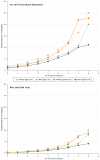Multimorbidity and Functional Limitations Among Adults 65 or Older, NHANES 2005-2012
- PMID: 27809419
- PMCID: PMC5094859
- DOI: 10.5888/pcd13.160174
Multimorbidity and Functional Limitations Among Adults 65 or Older, NHANES 2005-2012
Abstract
Introduction: The development of functional limitations among adults aged 65 or older has profound effects on individual and population resources. Improved understanding of the relationship between functional limitations and co-occurring chronic diseases (multimorbidity) is an emerging area of interest. The objective of this study was to investigate the association between multimorbidity and functional limitations among community-dwelling adults 65 or older in the United States and explore factors that modify this association.
Methods: We conducted a cross-sectional analysis of adults aged 65 or older using data from the National Health and Nutrition Examination Survey (NHANES) from 2005 through 2012. We used negative binomial regression to estimate the association between multimorbidity (≥2 concurrent diseases) and functional limitations and to determine whether the association differed by sex or age.
Results: The prevalence of multimorbidity in this population was 67% (95% confidence interval [CI], 65%-68%). Each additional chronic condition was associated with an increase in the number of functional limitations, and the association was stronger among those aged 75 or older than among those aged 65 to 74. For those aged 65 to 74, each additional chronic condition was associated with 1.35 (95% CI, 1.27-1.43) times the number of functional limitations for men and 1.62 times (95% CI, 1.31-2.02) the number of functional limitations for women. For those 75 or older, the associations increased to 1.71 (95% CI, 1.35-2.16) for men and 2.06 (95% CI, 1.51-2.81) for women for each additional chronic condition.
Conclusion: Multimorbidity was associated with increases in functional limitations, and the associations were stronger among women than among men and among adults aged 75 or older than among those aged 65 to 74. These findings underscore the importance of addressing age and sex differences when formulating prevention strategies.
Figures



References
-
- He W, Larsen LJ. Older Americans with a disability: 2008−2012. US Census Bureau, American Community Survey Reports. Washington (DC): US Government Printing Office; 2014.
-
- US Department of Health and Human Services. Healthy people 2020. US Department of Health and Human Services, Office of Disease Prevention and Health Promotion; 2011.
Publication types
MeSH terms
Grants and funding
LinkOut - more resources
Full Text Sources
Other Literature Sources
Medical
